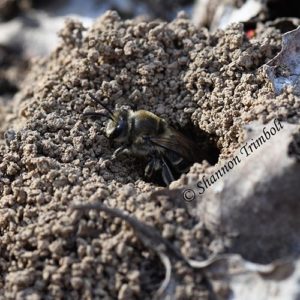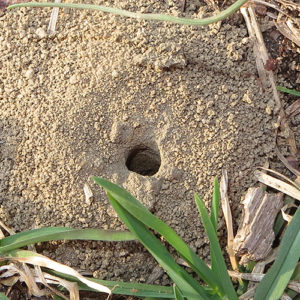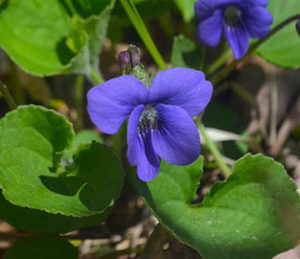
When most people think of bees, the non-native honeybee and the native bumble bees are what often come to mind because they are big and easily recognized. But there are thousands of other, lesser known species of native bees. Some of the most interesting are the many species of ground nesting bees that, as their name suggests, dig nests into the ground in which to raise their young. Although many people have never heard of ground nesting bees, ground nesting bees (also called mining bees, miner bees, or digger bees) account for approximately 70% of our native bees.
Please Don’t Confuse Them with Ground Nesting Wasps!
I have had people tell me several times they don’t want ground nesting bees because they are aggressive and sting. After a few quick questions it becomes apparent they are talking about yellowjackets – a species of social, ground nesting wasp that can be aggressive and definitely will sting when disturbed.
Our native ground nesting bees are quite the opposite. They are not social like honey bees, ants, or even the yellowjackets and their nests don’t have a lot of stores or resources to protect. The result is that our native ground nesting bees are not aggressive at all.
We have a nesting area on our property that I often walk right by. The bees don’t pay me a bit of attention, even when I get quite close to watch them or take pictures. If they pay me any attention, it is usually to fly away or hunker in their nests until they are sure I’m not a threat. So don’t be worried about having our native ground nesting bees making a home in your yard or garden.
Life Cycle
Many ground nesting bees get an early start and emerge from their burrows in the early spring before the trees leaf out. Mating occurs soon after the bees emerge. The females then begin to dig their nests. Each female will dig her own nest which usually consists of a single main tunnel with up to a handful of short side tunnels.
After the female digs her nest, she secretes a waterproofing substance from a gland on her abdomen. The substance soaks into the soil. The female uses a special, flat area near her rear to rub the soil until it is polished into a waterproof wall.
Once a side tunnel is complete, she’ll gather pollen and nectar which she forms into a small ball. Each side tunnel gets its own ball of nectar and pollen. She’ll then lay an egg on top of each ball of pollen and nectar before sealing the side tunnel so that each of her young will have its own “room.”
Depending on the species, the bee may spend as much as 11 months underground developing from an egg into an adult. Most species of ground nesting bees only live for a few weeks as an adult. In that short time the females have to dig a nest, mate, lay eggs, and provide food for their offspring. The adults then die and the whole process starts all over again with the eggs that are developing underground.
Not Social, But May Have Many Neighbors

While most ground nesting bees are solitary nesters – a female creates and maintains a burrow solely for herself – there can be a colony of several individual nest burrows in a small area. Whether this is due to the bees wanting to nest close to each other or due to them preferring a particular patch of ground to dig in is known only to the bees and may vary by species.
Although the burrows may be in close proximity to each other the females do not interact or help each other. Think of it kind of like a subdivision where each female has her own “house.” Since the bees are solitary, even a large concentration of nests still only accounts for a relatively small number of bees, compared to a hive of honeybees which can have tens of thousands of bees.
Where to Look for Ground Nesting Bees
In the early spring, watch for relatively small bees flying low to the ground, often fairly rapidly. (Many of these bees are approximately the size of a housefly.) The low, rapid flight pattern may indicate a potential nesting site.
Another sign to look for are the nesting sites themselves. To me, they often look like someone stabbed the ground with an old-fashioned number 2 pencil. The nesting holes sometimes also have mounds of dirt around them that resemble anthills, except the balls of dirt that make up the mound are much bigger than what you would find on an anthill. The dirt mounds are composed of the soil that the bee excavated while constructing her tunnel.
Once you find a nesting site, you can return around the same time every year and will likely be able to find the bees there again assuming nothing has changed in the area.
How Can You Provide Them with Nesting Habitat?
Providing habitat for ground nesting bees is relatively easy. Allow small patches of sunny, bare or sparsely vegetated ground to exist in your yard. If the areas are relatively sandy, even better.
Don’t mulch or dig in these areas so you won’t disturb the tunnels. The tunnels of ground nesting bees range between a few inches to three feet deep depending on the species.
If you already have ground nesting bees on your property, protect those areas and count yourself lucky. Ground nesting bees are important pollinators of many early blooming plants.

Some Ground Nesting Bees Are Pollen Specialist
Much like butterflies and moths have specific host plants, many of the ground nesting bees have specific plants that they gather pollen from to feed themselves and their young. Having the right plants available to gather pollen from is just as important as having a place to make a nest.
Violets, hollies, and dogwoods are a few examples of well-known plants which have specialist species of ground nesting bees associated with them. Making sure pollen specialist bees in your area have food available is one way to take your pollinator garden to the next level.
Summary
Solitary, ground nesting bees make up the majority of our native bee species in North America. These bees have very interesting life cycles. Most of them are solitary nesters, are not aggressive, and are important early season pollinators.
You can attract ground nesting bees to your property by providing nesting areas and a variety of early blooming native plants including those known to often have pollen specialist bees associated with them. Ground nesting bees are also a lot of fun to just sit and watch as they go about the activities associated with making sure the next generation has the best chance of survival.

Backyard Ecology: Exploring Nature in Your Backyard
Nature isn’t just “out there.” It’s all around us, including right outside our doors. Hi, my name is Shannon Trimboli, and I am the host of Backyard Ecology. I live in southcentral Kentucky and am a wildlife biologist, educator, author, beekeeper, and owner of a nursery specializing in plants for pollinators and wildlife conservation. I invite you to join me as we ignite our curiosity and natural wonder, explore our yards and communities, and improve our local pollinator and wildlife habitat. Learn more or subscribe to my email list at www.backyardecology.net.

Leave a Reply